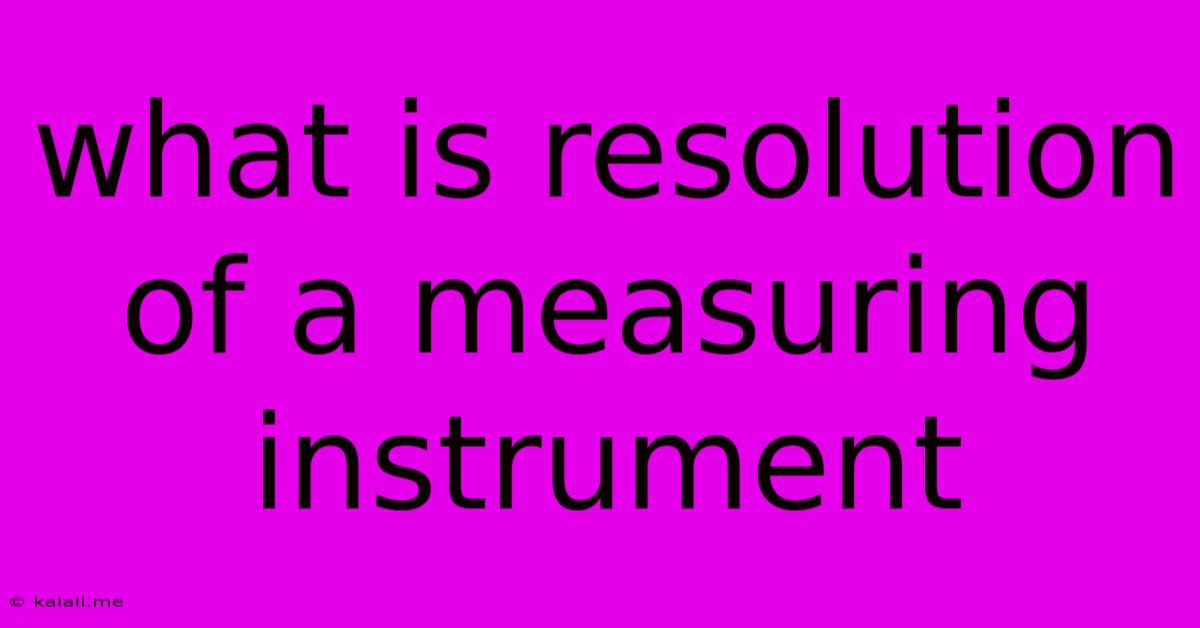What Is Resolution Of A Measuring Instrument
Kalali
Jun 15, 2025 · 3 min read

Table of Contents
Understanding the Resolution of a Measuring Instrument
The resolution of a measuring instrument is a crucial concept for anyone working with data acquisition and analysis. It fundamentally dictates the precision and accuracy of your measurements, directly impacting the reliability of your results. This article will delve into the definition of resolution, explore its different aspects, and discuss its implications in various fields. Understanding resolution is critical for selecting the right instrument for a specific task and interpreting the data it provides.
What is Resolution?
Simply put, the resolution of a measuring instrument refers to the smallest change in the measured quantity that the instrument can reliably detect and display. It represents the fineness of the instrument's measurement capabilities. Think of it as the smallest increment the instrument can differentiate between. For instance, a ruler with millimeter markings has a higher resolution than one with only centimeter markings. The former can distinguish smaller differences in length.
Types of Resolution
Resolution isn't a one-size-fits-all concept. Different types exist, depending on the nature of the instrument and the measured quantity:
-
Digital Resolution: This refers to the smallest increment a digital instrument can display. For example, a digital scale showing weights to the nearest 0.1 gram has a digital resolution of 0.1 grams. This is often expressed in terms of the number of significant figures displayed.
-
Analog Resolution: Analog instruments, like a traditional thermometer with a continuous scale, have resolution determined by the smallest division marked on the scale. The user's ability to estimate between markings introduces a degree of uncertainty. Analog resolution is inherently less precise than digital resolution.
-
Spatial Resolution: This applies to imaging instruments like cameras or microscopes. It refers to the smallest distance between two distinguishable points in the image. Higher spatial resolution means finer details can be discerned.
-
Temporal Resolution: Relevant for instruments measuring changes over time, like an oscilloscope or a heart rate monitor. It's the smallest time interval between successive measurements.
Factors Affecting Resolution
Several factors influence the resolution of a measuring instrument:
-
Instrument Design: The underlying technology and construction of the instrument directly affect its ability to detect small changes.
-
Calibration: Proper calibration ensures that the instrument's readings are accurate and consistent within its specified resolution. A poorly calibrated instrument can significantly reduce effective resolution.
-
Environmental Conditions: Factors like temperature, humidity, and vibrations can affect the accuracy of readings and, consequently, the instrument's apparent resolution.
-
Signal-to-Noise Ratio: Noise in the measurement signal can obscure small changes, limiting the effective resolution.
The Importance of Understanding Resolution
Understanding the resolution of your measuring instrument is critical for:
-
Data Interpretation: Knowing the resolution allows you to assess the uncertainty associated with your measurements.
-
Experiment Design: Choosing an instrument with sufficient resolution is crucial to obtain accurate and meaningful data. Using an instrument with insufficient resolution can lead to significant errors.
-
Comparing Results: When comparing data from multiple instruments, it's essential to consider their respective resolutions to ensure valid comparisons.
Conclusion
The resolution of a measuring instrument is a fundamental characteristic that defines its precision and accuracy. Understanding the different types of resolution and the factors influencing it is essential for anyone working with measurement data. Selecting the appropriate instrument with adequate resolution for a given task is paramount for achieving reliable and meaningful results, avoiding misinterpretations, and ensuring the overall integrity of your research or project.
Latest Posts
Latest Posts
-
Which Is The Longest Phase Of Mitosis
Jun 15, 2025
-
For A Given Wave If The Frequency Doubles The Wavelength
Jun 15, 2025
-
The Founding Playwright Of The Realist Era Was
Jun 15, 2025
-
Consider The Circuit Shown In The Figure
Jun 15, 2025
-
Which Of The Following Are Characteristics Of Service Provider Operations
Jun 15, 2025
Related Post
Thank you for visiting our website which covers about What Is Resolution Of A Measuring Instrument . We hope the information provided has been useful to you. Feel free to contact us if you have any questions or need further assistance. See you next time and don't miss to bookmark.